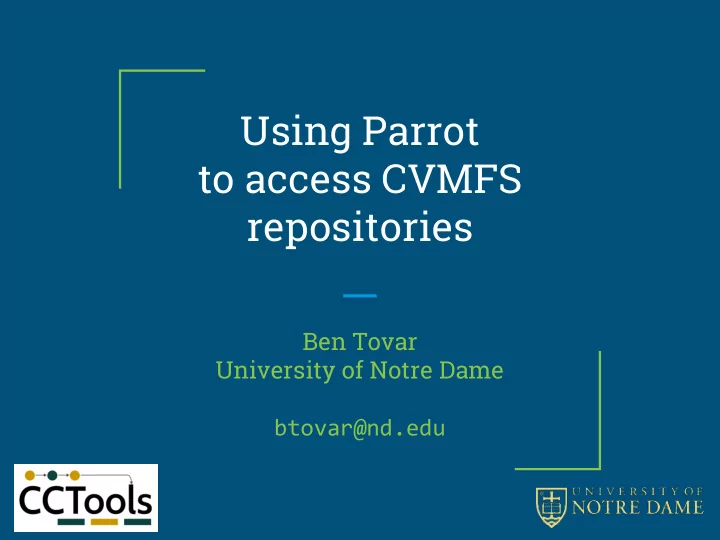

Using Parrot to access CVMFS repositories Ben Tovar University of Notre Dame btovar@nd.edu
Who we are Scientist says: "This example runs on my laptop, but I need much more for the real application. It would be great if we can run O(10K) tasks like this on this cloud/grid/cluster I have heard so much about."
Who we are The Cooperative Computing Lab Computer Science and Engineering University of Notre Dame
Who we are The Cooperative Computing Lab Computer Science and Engineering University of Notre Dame
Cooperative Computing Lab Not shown, grad students: Tim Shaffer , Chao Zheng
CCL Objectives • Harness all the resources that are available: desktops, clusters, clouds, and grids. • Make it easy to scale up from one desktop to national scale infrastructure. • Provide familiar interfaces that make it easy to connect existing apps together. • Allow portability across operating systems, storage systems, middleware… • Make simple things easy, and complex things possible. • No special privileges required.
CCTools • Open source, GNU General Public License. • Compiles in 1-2 minutes, installs in $HOME. • Runs on Linux, Solaris, MacOS, Cygwin, FreeBSD, … • Interoperates with many distributed computing systems. – Condor, SGE, Torque, Globus, iRODS, Hadoop… • Components: – Makeflow – A portable workflow manager. – Work Queue – A lightweight distributed execution system. – All-Pairs / Wavefront / SAND – Specialized execution engines. – Parrot – A personal user-level virtual file system. – Chirp – A user-level distributed filesystem.
CVMFS for Deploying HEP Software Stack Get file from cache, or CVMFS HEP analysis Task repository. Analysis software is CVMFS over FUSE distributed via With FUSE, the CVMFS, a read-only linux kernel remote software is filesystem over local as far as the HTTP. task is concerned.
Parrot and CVMFS: Main Idea Run CVMFS based applications without setting up the nodes where they run.
How HEP analysis Task open("/cvmfs/...") Get file from cache, parrot or CVMFS repository. linux kernel Parrot is a tool for attaching existing programs to remote I/O systems through the filesystem interface.
Why? You may not own the machines (e.g. opportunistic resources like Condor) ● You may not have admin. privileges on the machines. ● Easier to move a mountain, than to convince your sys admin to install a kernel ● module. You are running in a container, and the host system does not have CVMFS. ● The machine may have limited, or no external connectivity at all. ●
Static User Policy /data = /gsiftp/ftp.cs.wisc.edu/x5 /etc = /chirp/coral.cs.wisc.edu/etc Ordinary /tmp = DENY Program (POSIX Interface) (Ptrace trap) Name Resolution and Security Policies The Parrot Virtual File System Local (Policy) Cache HTTP FTP IRODS CVMFS Chirp Condor Proxy (I/O) Whole File I/O Partial File I/O Secure (get/put) Remote (open,close,read,write, lseek) RPC Dynamic HTTP FTP Chirp IRODS CVMFS Condor User Server Server Server rep. Server Shadow Policy Traditional Full UNIX Full UNIX Integration Read only I/O Services Semantics Semantics with Condor
Parrot in CMS (ND Lobster, last year results) This year O(25k) cores on non-dedicated resources.
ND CMS + CCTools + libCVMFS + CRC ~ Lobster Anna Woodard Ben Tovar Jakob Blomer Paul Brenner Matthias Wolf Patrick Donnelly Dan Bradley Serguei Fedorov Kenjy Hurtado Douglas Thain Rene Meusel Charles Mueller Nil Valls Kevin Lannon Michael Hildreth Lobster is a user-level system for deploying data intensive high-throughput application on non-dedicated resources. (parrot-cvmfs and CRC not required...)
condor.cse.nd.edu
Non-dedicated Lobster resources through condor CVMFS access through parrot Parrot deployed as just another job input file
Measuring overheads (a maximum of 4 tasks per worker/condor job)
Efficient access to the same data Using libcvmfs' alien cache with parrot. local cache per parrot alien cache per node
Measuring overheads many tasks, overhead few tasks, from other overhead parts of mostly from lobster parrot.
Parrot in Atlas (Rodney Walker) Rodney is using 'alien cache' to the extreme. LMU-München nodes have very limited outside connectivity. No connectivity ● to CERN. Making local copies of repositories was error prone, as CVMFS paths are not ● relocatable. ● Rodney has CVMFS releases of interest as an alien cache on GPFS, accessible by all parrot instances. (300 nodes, O(40K) nodes)). ● Size of alien cache is about 1TB. Atlas applications run non-the-wiser, as if they had access to CERN for ● CVMFS data.
CernVM as Docker container with parrot Work by Jakob Blomer and Tom Boccali. Technology preview! https://cernvm.cern.ch/portal/docker docker run -it my_cernvm /init ls -lad /cvmfs/...
parrot's dream use parrot_run a whole workflow
Parrot Troubles (just last week...)
parrot's recommended use parrot_run a whole parrot_run workflow parrot_run parrot has to mimic the kernel and de facto behaviour of glibc. It is a good way to discover the skeletons in the closet of the kernel and glibc. Thus, it is better to localize its use.
Questions btovar@nd.edu http://ccl.cse.nd.edu http://ccl.cse.nd.edu/downloads http://ccl.cse.nd.edu/community/forum https://github.com/cooperative-computing-lab/cctools
Recommend
More recommend